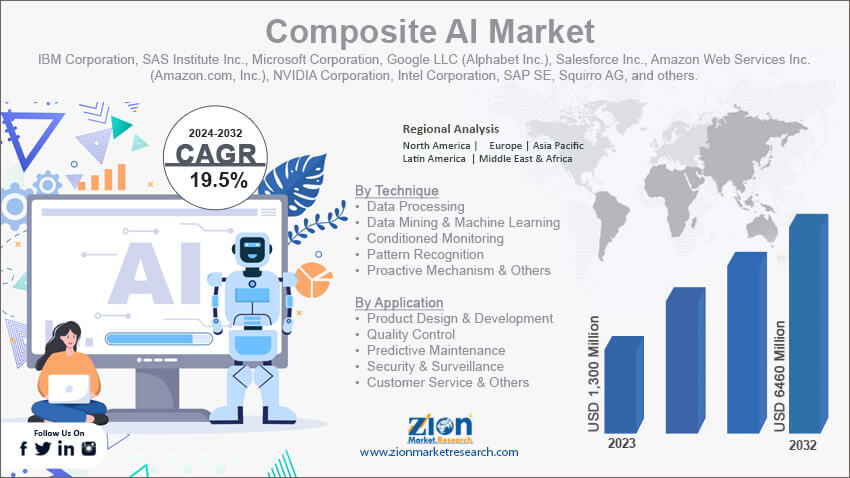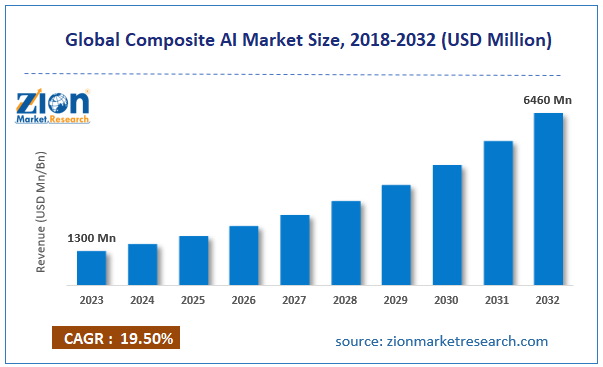Composite AI Market Size, Share, Analysis, Trends, Growth, Forecasts, 2032

Composite AI Market By Offering (Hardware, Software, and Services), By Technique (Data Processing, Data Mining & Machine Learning, Conditioned Monitoring, Pattern Recognition, Proactive Mechanism, and Others), By Application (Product Design & Development, Quality Control, Predictive Maintenance, Security & Surveillance, and Customer Service & Others), By Vertical (BFSI, Telecommunications, Retail & eCommerce, Healthcare & Lifesciences, Media & Entertainment, Energy & Power, Transportation & Logistics, Government & Defense, Manufacturing, and Others), and By Region - Global and Regional Industry Overview, Market Intelligence, Comprehensive Analysis, Historical Data, and Forecasts 2024 - 2032-
| Market Size in 2023 | Market Forecast in 2032 | CAGR (in %) | Base Year |
|---|---|---|---|
| USD 1,300 Million | USD 6460 Million | 19.5% | 2023 |
Composite AI Industry Prospective:
The global composite AI market size was worth around USD 1,300 million in 2023 and is predicted to grow to around USD 6460 million by 2032 with a compound annual growth rate (CAGR) of roughly 19.5% between 2024 and 2032.
Composite AI Market: Overview
Composite AI acknowledges the lack of a single general-purpose AI method. Businesses frequently integrate various AI with other analytical tools to get the best outcomes when addressing complicated business problems.
Composite AI, sometimes referred to as multidisciplinary AI, is the application of many AI approaches in combination to increase learning efficiency and expand the level of knowledge representations. Using ML as a "one size fits all" strategy will not be as sensible as using other AI techniques or, more frequently, a combination of techniques.
Therefore, it is recommended that a "composite architecture" be used to build a composite AI system. This design should include natural language processing (NLP), optimization techniques, graph approaches, and classic rules-based systems.
Key Insights
- As per the analysis shared by our research analyst, the global Composite AI market is estimated to grow annually at a CAGR of around 19.5% over the forecast period (2024-2032).
- In terms of revenue, the global Composite AI market size was valued at around USD 1,300 million in 2023 and is projected to reach USD 6460 million by 2032.
- The increasing collaboration is expected to drive the Composite AI industry over the forecast period.
- Based on the technique, data mining & machine learning is expected to hold a major market share over the projected period.
- Based on the vertical, the BFSI segment is expected to capture the largest market share over the projected period.
- Based on region, North America is expected to dominate the market during the forecast period.
 Request Free Sample
Request Free Sample
Composite AI Market: Growth Drivers
Emergence of IoT and edge computing drives market growth
The widespread use of Internet of Things (IoT) devices and the requirement for real-time decision-making are driving the use of edge computing. Composite AI systems connected to edge devices may reduce latency and provide faster insights and responses by locally processing and interpreting data. The implementation of composite AI solutions in edge computing environments is made feasible by this integration. Edge computing is essential to 5G/6G Internet of Things (IoT) networks and intelligent applications.
For efficient data analysis and insight extraction, the IoT ecosystem generates massive, diverse, incredibly noisy, spatiotemporal-correlated, real-time data streams that require intelligent learning. These gadgets consist of memory units, mobile phones, and sensors. Thus, this is expected to drive the Composite AI market.
Composite AI Market: Restraints
High implementation cost hinders market growth
The high implementation expenses are one major deterrent for businesses considering implementing Composite AI technologies. Composite AI technologies may not be accessible to small and medium-sized businesses (SMEs) due to high implementation costs, especially if they lack the requisite funding. This may cause big businesses and smaller businesses to adopt cutting-edge AI technologies differently.
Furthermore, the high upfront expenses can discourage businesses from spending money on Composite AI because they are unsure if they would get a positive return on investment. This may result in a cautious approach to the adoption of new technology. Thus, the high implementation cost might be limiting the Composite AI industry.
Composite AI Market: Opportunities
Growing collaborations in the sector offer a lucrative opportunity for market growth
The increasing collaboration among the market players is expected to propel the Composite AI market over the forecast period. For instance, in June 2023, Microsoft and HCLTech, a prominent international technology company, announced the extension of their strategic relationship to assist organizations in utilizing generative artificial intelligence (AI) and creating collaborative solutions that would improve business transformation and help them get better results.
Clients will gain from cutting-edge solutions that boost worker productivity, simplify IT operations, quicken application development, and streamline corporate procedures by utilizing HCLTech's extensive domain expertise across many sectors and Microsoft's Azure OpenAI Service. OpenAI's language models, including the GPT-3, Codex, and Embeddings model family, can be accessed via REST (Representational State Transfer) APIs through Azure OpenAI Service.
Composite AI Market: Challenges
The complexity of integration poses a major challenge to market expansion
It can be technically challenging to integrate many AI approaches, such as computer vision, machine learning, deep learning, and natural language processing (NLP), since each one requires unique setups and frameworks. To get the intended results, these have to cooperate, which can be difficult.
Furthermore, a strong infrastructure that can manage large data loads and execute several algorithms concurrently is necessary for composite AI systems. The integration procedure may get more complicated if organizations must rely on cloud-based solutions or improve their computing capacity. Consequently, the composite AI market is confronted with a major challenge.
Composite AI Market: Segmentation
The global Composite AI industry is segmented based on the offering, technique, application, vertical, and region.
Based on the offering, the global Composite AI market is segmented into hardware, software, and services.
Based on the technique, the global Composite AI industry is bifurcated into data processing, data mining & machine learning, conditioned monitoring, pattern recognition, proactive mechanisms, and others. Data mining & machine learning are expected to hold a major market share over the projected period.
Composite AI solutions may examine enormous datasets to find trends, patterns, and undiscovered insights by fusing data mining and machine learning. Businesses may increase operational effectiveness, generate new revenue sources, and make data-driven decisions due to this capacity. Predictive models, for example, can help the retail and financial industries by anticipating consumer behavior and improving the quality of their product offerings and services.
Based on the application, the global Composite AI market is bifurcated into product design & development, quality control, predictive maintenance, security & surveillance, and customer service & others.
Based on the vertical, the global Composite AI market is bifurcated into BFSI, telecommunications, retail & e-commerce, healthcare & life sciences, media & entertainment, energy & power, transportation & logistics, government & defense, manufacturing, and others. The BFSI segment is expected to capture the largest market share over the projected period. One of the main drivers of revenue growth in the banking, financial services, and insurance (BFSI) industry is the integration of composite artificial intelligence.
Utilizing a variety of AI techniques, including data mining, machine learning, and natural language processing, Composite AI gives BFSI organizations strong instruments to boost customer satisfaction, optimize workflows, and strengthen risk control. Organizations can obtain a competitive edge with this multidimensional strategy, which immediately increases sales and profitability.
Composite AI Market: Report Scope
| Report Attributes | Report Details |
|---|---|
| Report Name | Composite AI Market |
| Market Size in 2023 | USD 1,300 Million |
| Market Forecast in 2032 | USD 6,460 Million |
| Growth Rate | CAGR of 19.5% |
| Number of Pages | 226 |
| Key Companies Covered | IBM Corporation, SAS Institute Inc., Microsoft Corporation, Google LLC (Alphabet Inc.), Salesforce Inc., Amazon Web Services Inc. (Amazon.com, Inc.), NVIDIA Corporation, Intel Corporation, SAP SE, Squirro AG, and others. |
| Segments Covered | By Offering, By Technique, By Application, By Vertical, and By Region |
| Regions Covered | North America, Europe, Asia Pacific (APAC), Latin America, Middle East, and Africa (MEA) |
| Base Year | 2023 |
| Historical Year | 2018 to 2022 |
| Forecast Year | 2024 - 2032 |
| Customization Scope | Avail customized purchase options to meet your exact research needs. Request For Customization |
Composite AI Market: Regional Analysis
North America dominates the market over the projected period
North America is expected to lead the global Composite AI market growth. The expansion in the region can be attributed to its strong technological infrastructure, creative ecology, and substantial investments in AI research & development. A thriving environment for AI innovation and entrepreneurship is created by the area, which is home to prominent tech centers like Silicon Valley in the US and emerging AI clusters throughout Canada.
North America's impact on the composite AI industry is driven by several variables. A constant flow of AI developments and applications across numerous industries is ensured by the existence of significant tech firms like Google, Microsoft, and IBM.
Composite AI Market: Competitive Analysis
The global Composite AI market is dominated by players like:
- IBM Corporation
- SAS Institute Inc.
- Microsoft Corporation
- Google LLC (Alphabet Inc.)
- Salesforce Inc.
- Amazon Web Services Inc. (Amazon.com. Inc.)
- NVIDIA Corporation
- Intel Corporation
- SAP SE
- Squirro AG
The global Composite AI market is segmented as follows:
By Offering
- Hardware
- Software
- Services
By Technique
- Data Processing
- Data Mining & Machine Learning
- Conditioned Monitoring
- Pattern Recognition
- Proactive Mechanism & Others
By Application
- Product Design & Development
- Quality Control
- Predictive Maintenance
- Security & Surveillance
- Customer Service & Others
By Vertical
- BFSI
- Telecommunications
- Retail and eCommerce
- Healthcare and Lifesciences
- Media and Entertainment
- Energy and Power
- Transportation and Logistics
- Government and Defense
- Manufacturing
- Others
By Region
- North America
- The U.S.
- Canada
- Europe
- France
- The UK
- Spain
- Germany
- Italy
- Rest of Europe
- Asia Pacific
- China
- Japan
- India
- South Korea
- Southeast Asia
- Rest of Asia Pacific
- Latin America
- Brazil
- Mexico
- Rest of Latin America
- Middle East & Africa
- GCC
- South Africa
- Rest of Middle East & Africa
Table Of Content
Methodology
FrequentlyAsked Questions
Composite AI acknowledges the lack of a single general-purpose AI method. Businesses frequently integrate various AI with other analytical tools to get the best outcomes when addressing complicated business problems. Composite AI, sometimes referred to as multidisciplinary AI, is the application of many AI approaches in combination to increase learning efficiency and expand the level of knowledge representations. Using ML as a "one size fits all" strategy will not be as sensible as using other AI techniques or, more frequently, a combination of techniques. Therefore, it is recommended that a "composite architecture" be used to build a composite AI system. This design should include natural language processing (NLP), optimization techniques, graph approaches, and classic rules-based systems.
The composite AI market growth is driven by several factors, including increasing product launches, rising collaboration, technological advancements, and others.
According to the report, the global composite AI market size was worth around USD 1,300 million in 2023 and is predicted to grow to around USD 6460 million by 2032.
The global Composite AI market is expected to grow at a CAGR of 19.5% during the forecast period.
The global composite AI market growth is expected to be driven by North America. It is currently the world’s highest revenue-generating market due to the presence of major players.
The global Composite AI market is dominated by players like IBM Corporation, SAS Institute, Inc., Microsoft Corporation, Google LLC (Alphabet Inc.), Salesforce, Inc., Amazon Web Services, Inc. (Amazon.com, Inc.), NVIDIA Corporation, Intel Corporation, SAP SE and Squirro AG among others.
The composite AI market report covers the geographical market along with a comprehensive competitive landscape analysis. It also includes cash flow analysis, profit ratio analysis, market basket analysis, market attractiveness analysis, sentiment analysis, PESTLE analysis, trend analysis, SWOT analysis, trade area analysis, demand & supply analysis, Porter’s five forces analysis, and value chain analysis.
HappyClients
Zion Market Research
Tel: +1 (302) 444-0166
USA/Canada Toll Free No.+1 (855) 465-4651
3rd Floor,
Mrunal Paradise, Opp Maharaja Hotel,
Pimple Gurav, Pune 411061,
Maharashtra, India
Phone No +91 7768 006 007, +91 7768 006 008
US OFFICE NO +1 (302) 444-0166
US/CAN TOLL FREE +1 (855) 465-4651
Email: sales@zionmarketresearch.com
We have secured system to process your transaction.
Our support available to help you 24 hours a day, five days a week.
Monday - Friday: 9AM - 6PM
Saturday - Sunday: Closed






